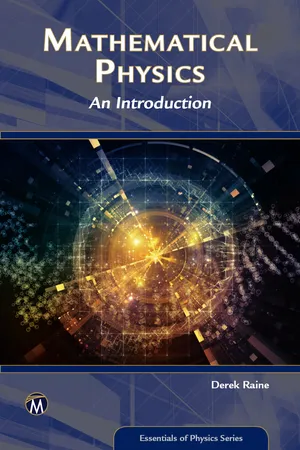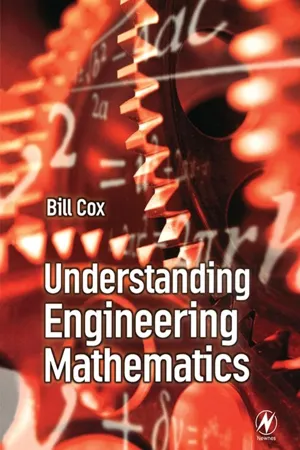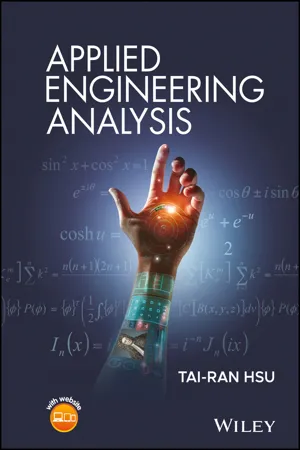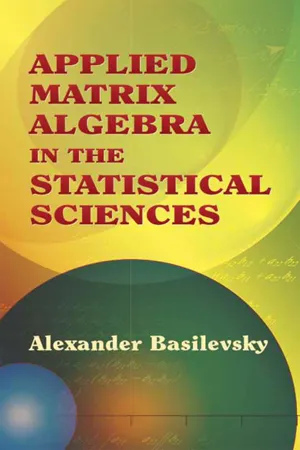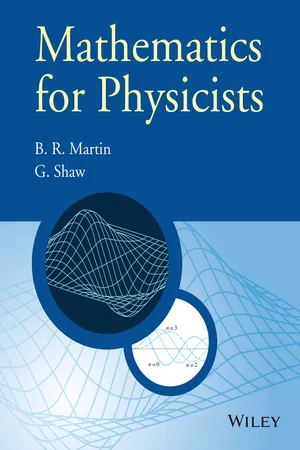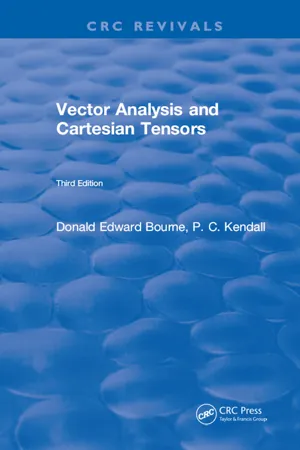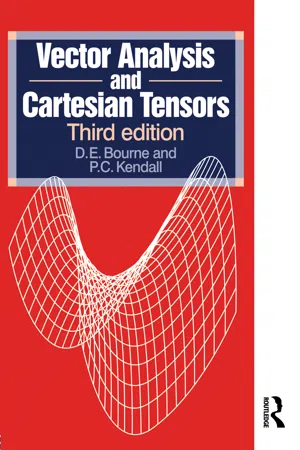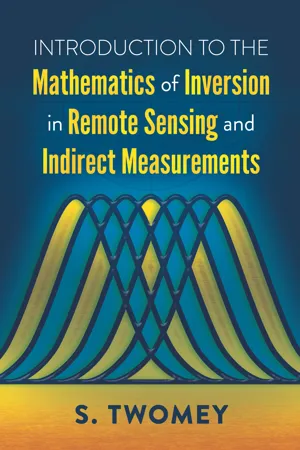Physics
Vectors in Multiple Dimensions
Vectors in multiple dimensions refer to quantities that have both magnitude and direction in a space with more than one dimension. In physics, these vectors are often used to represent physical quantities such as force, velocity, and acceleration in three-dimensional space. They are typically represented using coordinates and can be added, subtracted, and multiplied by scalars.
Written by Perlego with AI-assistance
Related key terms
12 Key excerpts on "Vectors in Multiple Dimensions"
- eBook - ePub
Mathematical Physics
An Introduction
- Derek Raine(Author)
- 2018(Publication Date)
- Mercury Learning and Information(Publisher)
4VECTORS
The physical world (as we perceive it) exists in three spatial dimensions. Physical quantities such as velocities – which have both magnitude and direction – need three components for their specification. We call these vectors . (In fact, even more than this, a chemical system, or an economic model may have, say, 20 components; such a system can often be represented conveniently by a vector in the appropriate number of dimensions (20 in this example): the algebra is the same.) You are going to learn to do algebra with vectors (add and multiply them) in a geometrically meaningful way.The first part of the chapter deals with the algebra and the second with the geometrical picture. You can think of this in two ways: either that the algebra enables you to do complicated geometrical things rather mechanically (by following the algebraic rules), or that the geometry enables you to get a picture of the algebra. In either case you have to learn to switch smoothly between the two methods, and this requires practice. Your reward will be command of a mathematical tool that pervades physics.FIGURE 4.1: (a) The vectors and . (b) The parallelogram law of vector addition.4.1.BASIC PROPERTIES
Definition: A vector is an object with a magnitude and a direction.Therefore any vector can be represented by a line segment with the specified length (or magnitude) and direction. Note that this picture provides a representation of any physical quantity, for example a force, that can be described by a magnitude and direction in space.It does not say that a vector is an arrow, only that they behave geometrically in the same way. (Bodies are accelerated by forces, not by arrows on a page.) This is important: many physical quantities are not represented by spatial arrows (velocities and forces in relativity theory, for example).A line segment with end-points A and B can be written . The line segment is a vector of the same magnitude but opposite direction (indicated by the direction of the arrowhead in Figure 4.1 - eBook - ePub
- Bill Cox(Author)
- 2001(Publication Date)
- Butterworth-Heinemann(Publisher)
11Vectors
Vectors are the mathematical tools needed when we deal with engineering systems in more than one dimension. Vector quantities such as force have both a magnitude and direction associated with them, and so are represented by mathematical symbols that, similarly, have a magnitude and direction. We can construct an algebra of such quantities by which they may be added, subtracted, multiplied (in two different ways) – but not divided. These rules of combination reflect the ways in which the corresponding physical quantities behave – for example vectors add in the same way that forces do, the scalar product represents ‘vector times vector = scalar’ in the same way that ‘velocity times velocity = energy’. By introducing a coordinate system, we can also represent vectors by arrays of ordinary numbers, in which form they are easier to combine and manipulate.Prerequisites It will be useful if you know something about•ratio and proportion (14 )•Cartesian coordinate systems (205 )•Pythagoras’ theorem (154 )•sines and cosines (175 )•cosine rule (197 )•simultaneous linear equations (48 )•function notation (90 )•differentiation (Chapter 8 )Objectives In this chapter you will find• definitions of scalars and vectors• representation of a vector• addition and subtraction of vectors• multiplication of a vector by a scalar• rectangular Cartesian coordinates in three dimensions• distance in Cartesian coordinates• direction cosines and ratios• angle between two lines•basis vectors (i , j , k - eBook - ePub
Doing Physics with Scientific Notebook
A Problem Solving Approach
- Joseph Gallant(Author)
- 2012(Publication Date)
- Wiley(Publisher)
Chapter 3Vectors
In the previous chapter, we described 1-dimensional motion. We specified an object’s position along one axis as either positive or negative. All information about the direction was carried by the sign.The universe is not 1-dimensional. There are more complicated motions that require more complicated descriptions. Fortunately, there are mathematical tools called vectors that will allow us to extend our study of motion to 2 and 3 dimensions. Vectors turn a difficult 2-d problem into two easy 1-d problems. That is a good trade.Many physical quantities can be described by a single number and a unit. Room temperature is approximately 21 °C and a typical class lasts about 3600 s. These numbers are called scalars. Temperature and time are examples of scalars. Scalars obey the usual rules of arithmetic. You can punch them into your calculator or use SNB. Scalars are old friends, the numbers you’ve been using for a long time. We just gave them a new name.Sometimes scalars are inadequate. Consider the following simple example. Suppose you walk 5 m, stop, then walk another 12 m. How far from your original location are you? It depends on the direction! Where you end up depends on both how far and in which direction you walk.If you only walk in one direction, you end up 5 m + 12 m = 17 m away from your initial position. If you walk 5 m to the left and then turn around and walk 12 m to the right, you end up 12 m - 5 m = 7 m to the right of your initial position. If you walk forward 5 m, turn right and walk another 12 m, you end up 13 m away from your initial position.Such quantities are called vectors. Vectors are mathematical quantities that have magnitude and direction. The vector’s magnitude tells us how much of the physical quantity we have. As Figure 3.1 - eBook - ePub
- Tai-Ran Hsu(Author)
- 2018(Publication Date)
- Wiley(Publisher)
Figure 3.3 Vector in rectangular and cylindrical coordinate systems. (a) A vector in three-dimensional space. (b) Rectangular unit vectors.Figure 3.3 b illustrates another way to represent a vector, in this case in three-dimensional space; for instance, the position vector A with its initial point coinciding with the origin of the coordinate system and its terminal point situated at point P at a position with coordinates (x,y,z) in a rectangular coordinate system. This position vector may be expressed in the following way:3.3where i, j, and k are the “unit vectors” along the x-, y-, and z-coordinate directions, respectively, as shown Figure 3.3 b. Unit vectors are used to designate the direction of scalar quantities. For example, in Equation 3.3 , the term yj indicates the vector quantity with a magnitude of y but in the direction of the vector j along the y-coordinate. Each of these three unit vectors in Figure 3.3 b has a magnitude of 1.0.The magnitude of vector A can be obtained by using the Pythagorean rule:3.43.2.1 Position Vectors
A position vector such as the vector A of a point located at (x1 , y1 ) illustrated in Figure 3.3 a. The position of this point may be represented by a vector r in Figure 3.4 a. This vector often is known as the location vector of the point P in space, or the radius vector that represents the position of point P in a space defined by a coordinate system with an arbitrary reference origin O in Figure 3.4 b. The position vector is used in describing the motion of “particles” or “rigid bodies” in a planar two-dimensional space or in three-dimensional space.Position vectors. (a) In the two-dimensional plane. (b) In three-dimensional space.Figure 3.4The position vector r in Figure 3.4 b can be decomposed into three components as r = rx + ry + rz , with rx , ry , and rz being the components of the position vector r along the x-, y-, and z-coordinates, respectively. These components may be expressed using the unit vectors i, j, and k as defined in Figure 3.3 b, with rx = x1 i, ry = y1 j, and rz = z1 k - Alexander Basilevsky(Author)
- 2013(Publication Date)
- Dover Publications(Publisher)
The inner product of Definition 1.1 is a binary operation, since only two vectors are involved. The concept, however, may be extended to more than two vectors. For example, we can define the productX 1 X 2 X 3 = x 11 x 21 x 31 + x 12 x 22 x 32 + ... + xSuch products, however, are not frequently employed.1nx2nx3n .1.5 The Dimension of a Vector: Unit Vectors
An important concept in linear algebra is that of “dimension,” which plays a key role in the theory of vector spaces and their application to quantitative research and statistical data analysis. We are all aware of the existence of spatial dimensions in our physical (geographical) space. Thus the usual physical space that we perceive, such as a room, is three dimensional; the flat surface of a wall is two dimensional, and the straight line where wall and ceiling intersect is one dimensional. Naturally this refers to perfect (ideal) geometric objects, since in practice there is always some random distortion. Thus our physical space lends itself naturally to dimensional description.Other phenomena can also be depicted or modeled by means of dimensions. Consider two commuters A and B, who travel to work in the city center. Assume that A lives farther from the center of town than B, but has access to a more rapid means of transportation (train versus bus). It is then possible for A to reach the city center before B. Thus although A lives farther from the city center in terms of mileage, he is nevertheless closer in terms of the time dimension. Similarly, a third individual C, who lives even farther away from the city center than both A and B, but who can afford a more expensive mode of travel (helicopter, say), is closer to the city center in yet another dimension, a “wealth dimension.” We therefore have three potential determinants of travel time: distance (mileage), speed of travel (miles per hour), and income (dollar amount per year). Travel time can therefore be described in terms of three dimensions.The concept of dimensionality also permits us to organize and interpret data in a systematic manner. Consider four consecutive yearly time periods, the years 1977–1980, during which data are collected on the following variables:- eBook - ePub
- Brian R. Martin, Graham Shaw(Authors)
- 2015(Publication Date)
- Wiley(Publisher)
8 VectorsIn previous chapters we have been concerned exclusively with quantities that are completely specified by their magnitude. These are called scalar quantities, or simply scalars. If they have dimensions, then these also must be specified, in appropriate units. Examples of scalars are temperature, electric charge and mass. In physical science one also meets quantities that are specified by both their magnitude (again in appropriate units) and their direction. Provided they obey the particular law of addition specified below, these are called vector quantities, or just vectors. Examples are force, velocity and magnetic field strength. In this chapter we will be concerned with the algebraic manipulation of vectors, their use in co-ordinate geometry and the most elementary aspects of their calculus. In Chapter 12 we will discuss in more detail the calculus of vectors and vector analysis.8.1 Scalars and vectors
Because vectors depend on both magnitude and direction, a convenient representation of a vector is by a line with the direction indicated by an arrow anywhere along it, often at its end as shown in Figure 8.1 a. The vector represented by the line OA is printed in bold face type a (or if hand-written, as or ). The magnitude of a is the length of the line OA and is a scalar. It is written |a| or a. Vectors are equal if they have the same magnitude and are parallel. Thus in Figure 8.1 b, all three vectors a1 , a2 and a3 have the same magnitude and are parallel and hence are equal. However, in Figure 8.1 c the vectors a1 and a4 have the same magnitude but are antiparallel and a1 = −a4 , that is, reversing the direction of a vector while keeping its magnitude the same changes its sign.Figure 8.1Graphical representation of vectors.The law of addition is same law that applies to displacements, in which points are moved in the direction of the vector by an amount that is equal to its magnitude. This yields the triangle law of addition, shown by the construction of Figure 8.2 . Here the vector b is added to the vector a to yield the vector s = a + b - eBook - ePub
- Jamal T. Manassah(Author)
- 2017(Publication Date)
- CRC Press(Publisher)
7 VectorsIn this chapter, we consider both finite- and infinite-dimensional vectors. Using the Dirac notation, we show that the two cases can be conceptually treated in similar fashions. Very basic results from vector calculus in 2-D are used to solve the problem of planetary motion. In the last section, the Fourier series and the expansion in Legendre polynomials are used to illustrate the expansion in particular basis functions in infinite-dimensional spaces.7.1 Vectors in Two Dimensions
A vector in 2-D is defined by its length and the angle it makes with a reference axis (usually the x -axis). This vector is represented graphically by an arrow. The tail of the arrow is called the initial point of the vector and the tip of the arrow is the terminal point. Two vectors are equal when both their length and angle with a reference axis are equal.7.1.1 Addition
The sum of two vectorsis a vector constructed graphically as follows. At the tip of the first vector, draw a vector equal to the second vector, such that its tail coincides with the tip of the first vector. The resultant vector has as its tail that of the first vector, and as its tip, the tip of the just-drawn second vector (the Parallelogram rule) (see Figure 7.1 ).u →+v →=w →The negative of a vector is that vector whose tip and tail have been exchanged from those of the vector. This leads to the conclusion that the difference of two vectors is the other diagonal in the parallelogram (Figure 7.2 ).7.1.2 Multiplication of a Vector by a Real Number
If we multiply a vectorv →by a real number k , the result is a vector whose length is k times the length ofv →, and whose direction is that ofv →if k is positive, and opposite if k is negative.FIGURE 7.1 Sum of two vectors.FIGURE 7.2 Difference of two vectors.7.1.3 Cartesian Representation
It is most convenient for a vector to be described by its projections on the x -axis and on the y -axis, respectively; these are denoted by (v 1 , v 2 ) or (vx,vy - eBook - ePub
- Michael M. Mansfield, Colm O'Sullivan(Authors)
- 2020(Publication Date)
- Wiley(Publisher)
4 Motion in two and three dimensionsAIMS
- to show how, in two and three dimensions, physical quantities can be represented by mathematical entities called vectors
- to rewrite the laws of dynamics in vector form
- to study how the laws of dynamics may be applied to bodies which are constrained to move on specific paths in two and three dimensions
- to describe how the effects of friction may be included in the analysis of dynamical problems
- to study the motion of bodies which are moving on circular paths
4.1 Vector physical quantities
The material universe is a three‐dimensional world. In our investigation of the laws of motion in Chapter 3 , however, we considered only one‐dimensional motion, that is situations in which a body moves on a straight line and in which all forces applied to the body are directed along this line of motion. If a force is applied to a body in a direction other than the direction of motion the body will no longer continue to move along this line. In general, the body will travel on some path in three‐dimensional space, the detail of the trajectory depending on the magnitude and direction of the applied force at every instant. Equation (3.3) as it stands is not sufficiently general to deal with such situations, for example the motion of a pendulum bob (Figure 4.1 ) or the motion of a planet around the Sun (Figure 4.2 ). Newton's second law needs to be generalised from the simple one‐dimensional form discussed in Chapter 3 .A pendulum comprising a mass attached to the end of a string; the mass can move on a path such that the distance from the fixed end of the string remains constant.Figure 4.1A similar problem arises if two or more forces act on a body simultaneously, for example when a number of tugs are manoeuvring a large ship (Figure 4.3 - eBook - ePub
Vector Analysis and Cartesian Tensors
Third Edition
- Donald Edward Bourne(Author)
- 2018(Publication Date)
- Chapman and Hall/CRC(Publisher)
P. The relationship will depend upon the relative position of the two sets of axes (which is defined by the direction cosines of one set relative to the other), and by continuing this reasoning on an intuitive basis it could be obtained explicitly.The formal definition which follows will be seen to fit into the pattern which the brief remarks above suggest. That vectors do indeed have an associated magnitude and direction will follow later in this section as a consequence of the definition and so the consistency of this with intuitive ideas will be confirmed.DefinitionA vector is any mathematical or physical entity which is such that:1. when it is associated with a set of rectangular cartesian axes Oxyz it can be represented completely by three scalars a1 , a2 , a3 related, in turn, to the axes of x, y, and z;2. the triad of scalars in 1 is invariant under a translation of the axes, i.e. if Oxyz, O′x′y′z′ are rectangular cartesian axes (with different origins O, O′) such that Ox is parallel to O′x′, Oy is parallel to O′y′ and Oz is parallel to O′z′, and if the triads associated with the two coordinate systems are(respectively, then)a 1 ′,a 2 ′,a 3 ′,a 1=a 1 ′,a 2=a 2 ′;a 3=a 3 ′3. if the triads of scalars associated with two sets of axes Oxyz, Ox′y′z′ (with the same origin O) are (a1 , a2 , a3 ),(respectively, and if the direction cosines of Ox′, Oy′, Oz′ relative to the axes Oxyz are given by the transformation matrix (1.12 ), then)a 1 ′,a 2 ′,a 3 ′a 1 ′=l 11a 1+l 12a 2+l 13a 3,a 2 ′=l 21a 1+l 22a 2+l 23a 3,a 3 ′=l 31a 1+l 32a 2+l 33a 3.(2.1) Introducing the summation convention, equations (2.1) reduce to
Vectors will be denoted by letters printed in heavy type. Thusa i ′=li ja j( i = 1 , 2 , 3 ) .(2.2) - P C Kendall(Author)
- 2017(Publication Date)
- Routledge(Publisher)
components, v 1 ′, v 2 ′, v 3 ′ say, of P relative to the new axes must be related in some way to the original components, for the two sets of components are each sufficient to define the motion of P. The relationship will depend upon the relative position of the two sets of axes (which is defined by the direction cosines of one set relative to the other), and by continuing this reasoning on an intuitive basis it could be obtained explicitly. The formal definition which follows will be seen to fit into the pattern which the brief remarks above suggest. That vectors do indeed have an associated magnitude and direction will follow later in this section as a consequence of the definition and so the consistency of this with intuitive ideas will be confirmed. Definition A vector is any mathematical or physical entity which is such that: when it is associated with a set of rectangular cartesian axes Oxyz it can be represented completely by three scalars a 1 a 2, a 3 related, in turn, to the axes of x, y, and z ; the triad of scalars in 1 is invariant under a translation of the axes, i.e. if Oxyz, O ′ x ′ y ′ z ′ are rectangular cartesian axes (with different origins O, O ′) such that Ox is parallel to O ′ x ′, Oy is parallel to O ′ y ′ and Oz is parallel to O ′ z ′, and if the triads associated with the two coordinate systems are (a 1, a 2, a 3), (a 1 ′, a 2 ′, a 3 ′) respectively,. then a 1 = a 1 ′, a 1 = a 2 ′, a 3 = a 3 ′ ; if the triads of scalars associated with two sets of axes Oxyz, Ox ′ y ′ z ′ (with the same origin O) are (a 1, a 2, a 3), (a 1 ′, a 2 ′, a 3 ′) respectively, and if the direction cosines of Ox ′, Oy ′, Oz ′ relative to the axes Oxyz are given by the transformation matrix (1.12),. then a 1 ′ = l 11 a 1 + l 12 a 2 + l 13 a 3, a 2 ′ = l 21 a 1 + l 22 a 2 + l 23 a 3, a 3 ′ = l 31 a 1 + l 32 a 2 + l 33 a 3. (2.1) Introducing the summation convention, equations (2.1) reduce- eBook - ePub
- Hiqmet Kamberaj(Author)
- 2021(Publication Date)
- De Gruyter(Publisher)
4 Two- and three-dimensional motionIn this chapter, we will discuss the kinematics of a particle moving in two and three dimensions. Utilizing two- and three-dimensional motion, we will be able to examine a variety of movements, starting with the motion of satellites in orbit to the flow of electrons in a uniform electric field. We will begin studying in more detail the vector nature of displacement, velocity, and acceleration. Similar to one-dimensional motion, we will also derive the kinematic equations for three-dimensional motion from these three quantities’ fundamental definitions. Then the projectile motion and uniform circular motion will be described in detail as particular cases of the movements in two dimensions.4.1 The displacement, velocity, and acceleration vectors
When we discussed the one-dimensional motion (see Chapter 3 ), we mentioned that the movement of an object along a straight line is thoroughly described in terms of its position as a function of time,x ( t ). For the two-dimensional motion, we will extend this idea to the movement in thex yplane.As a start, we describe a particle’s position by the position vector r pointing from the origin of some coordinate system to the particle located in thex yplane, as shown in Fig. 4.1 . At timet ithe particle is at point P, and at some later timet fit is at the position Q. The path from P to Q generally is not a straight line. As the particle moves from P to Q in the time intervalΔ t =, its position vector changes fromt f−t ir itor f.Definition 4.1 (Displacement vector).
The displacement is a vector, and the displacement of the particle is the difference between its final position and its initial position. We now formally define the displacement vector for the particle as the difference between its final position vector and its initial position vector:(4.1)Δ r =r f−r i.The direction ofΔ ris indicated in Fig. 4.1 from P to Q. Note that the magnitude ofΔ r - eBook - ePub
- S. Twomey(Author)
- 2019(Publication Date)
- Dover Publications(Publisher)
CHAPTER 4Physical and geometric aspects of vectors and matrices
It is easy to define matrix and vector products as we have just done but to the reader this will not often be very satisfying — why, he may ask, this particular definition, and he may envisage other operations involving arrays of numbers which equally well could be defined as matrix products. For example, why not define the product of two matrices so that a particular element in the product matrix is the product of the corresponding elements in the matrices being multiplied?To explain or, at least, justify the definitions it is necessary to apply matrices and vectors to some problem, even if it is a contrived one. One could invent an algebra for just about any definition of multiplication and the definitions given earlier are just one possible choice. Their reasonableness, relevance and consistency we will attempt to demonstrate by example.4.1. GEOMETRIC VECTORS
The very name “vector” has a geometric connotation and the parallel between a geometric vector and a set of three angles or three coordinates is obvious. We may specify position with respect to some rectangular axes by writing, for example,to specify the position of a point in space, or to categorize the radius vector from the origin of the coordinate system (i.e. the point where x = 0, y = 0, z = 0). This can be viewed as a single algebraic vector with elements 3, –2, 10. If we denote that vector by r , the distance of the point from the origin, or the length of the radius vector to that point is evidently given by:The distance between point (3, –2, 10) and point (1, 4, 5) is given by . If we use only symbols we may write a distance as , where the distance is measured between two points categorized by coordinates (x , y , z ) and (ξ , η , ζ ), respectively.We can, of course, change our coordinate system by changing the origin and/or by rotating the axes. If we only change the origin, say to (x 0 , y 0 , z 0 ) leaving the direction of the axes unchanged, then with respect to this new origin the coordinates become (x – x 0 , y – y 0 , z – z 0 ); the new x -values, do not involve the old y - or z -values, only the old x -values. But if we allow the reference axes to rotate, the situation is less simple. To take the simplest case of rotation first, suppose in Fig. 4.1 the solid axes are the original axes but we wish to change over to a new system of axes which are directed along the broken lines at an angle α to the old axes. The z
Index pages curate the most relevant extracts from our library of academic textbooks. They’ve been created using an in-house natural language model (NLM), each adding context and meaning to key research topics.
